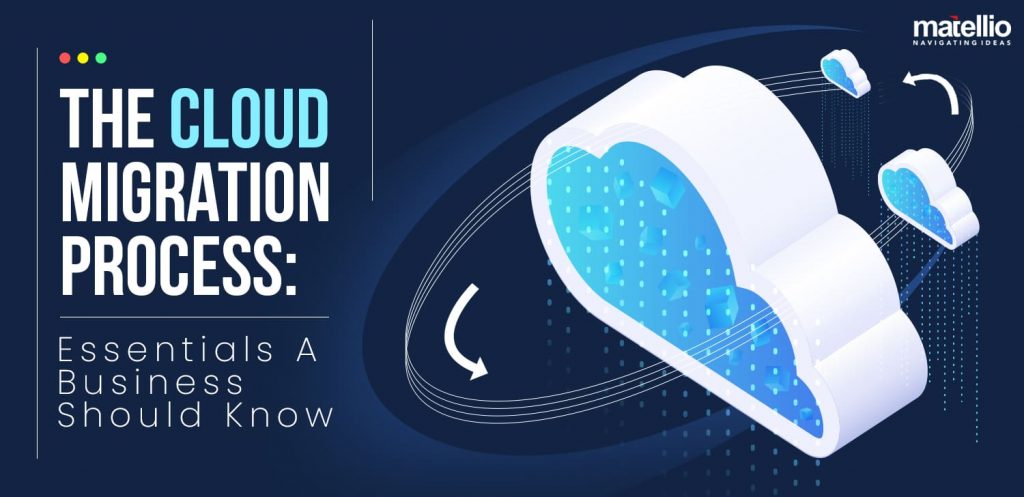
Are you looking for ways to keep up with the ever-evolving digital landscape and remain competitive in your industry? The cloud migration process is your way to go! It involves moving your organization’s data, applications, and other business elements from your on-premises infrastructure to the cloud. And the benefits are countless – from increased agility and cost savings to improved scalability and innovation.
After the pandemic, more and more businesses are realizing the importance of digital transformation and accelerating their move to the cloud. In fact, Gartner estimates that the global spending of end-users on public cloud services will increase by 20.7% and reach a total of $591.8 billion in 2023.
But don’t just jump in blindly- understanding the cloud migration process, its benefits, and its requirements is crucial to achieving a smooth transition. Whether you are a small startup or a large enterprise, cloud migration services can help you reinvent, reopen, and outmaneuver uncertainty. So, what are you waiting for? It’s time to unlock the full potential of the cloud and take your business to new heights!
What is Cloud Migration Process?
It is the process of transferring a company’s digital assets, services, databases, IT resources, and applications partially or completely to the cloud. It also involves moving from one cloud to another.
As technology evolves, many companies still find themselves dealing with outdated and inefficient legacy infrastructures, such as aging servers or unreliable firewall appliances. If you’re one of them, you must be looking towards the cloud migration process as a solution to experience the many benefits of cloud computing.
However, it’s important to understand that the process is not simply about moving to the cloud but also about ensuring that your business requirements are compatible with the cloud solution. That’s why the cloud migration process requires careful analysis, planning, and execution so that you can achieve real-time and updated performance and efficiency.
It’s a process that many companies are exploring as part of their cloud migration strategy. But there are many questions to be answered along the way. Therefore, businesses of all sizes often need the assistance of cloud integration services to make their cloud migration journey a success.
Luckily, we are here to serve you as your cloud migration service provider. We provide lift-and-shift cloud migration capabilities along with many other modernization services to help you get the most out of your move to the cloud. That said, let’s examine the benefits of this shift so you can understand its need for your business properly.
Benefits of Cloud Migration
As remote work and online demand continue to increase, many companies realize the need to migrate their data and services to the cloud. The cloud has also become essential for companies to leverage the power of next-gen technologies and succeed in implementing them.
Those who have already started the cloud migration process are accelerating their digital transformation, positioning themselves for success in the future. Those who have yet to make the move might wonder why they didn’t start earlier. If you are one of them, start with the process now to embrace the below-given benefits of cloud migration:-
Agility and Flexibility
Moving to the cloud means that your infrastructure can scale up or down based on your business needs, which allows you to be more responsive to changes in the market. This increased flexibility can help your company innovate faster and more effectively.
Cost Reduction
Reducing costs is another key benefit of cloud migration. When you discard the maintenance of your own physical infrastructure, you can save on hardware and maintenance costs. Additionally, many cloud migration service providers often offer pricing models that allow you to pay only for what you use, which can be huge cost savings.
Cloud Scalability
It is one of the key benefits you achieve after the cloud migration process. A cloud-based infrastructure lets you quickly and easily scale up or down based on your business needs, which can help you stay ahead of the competition.
Improved Collaboration
Cloud migration simplifies collaboration and promotes teamwork, enabling employees to work together seamlessly, regardless of location by allowing them to easily share resources, work on documents together, and more. This leads to greater efficiency and improved business outcomes.
Faster Innovation
The ability to innovate faster is a key benefit you harness after implementing the cloud migration process. By eliminating the need to manage your own infrastructure, you can free up resources to focus on developing new products and services. This can help you stay ahead of the competition and promptly meet your customers’ needs.
Shifting to Everything-As-A-Service
This may surprise you if you haven’t heard about what comes after cloud migration. Once you migrate to the cloud, you can swiftly shift your business to everything-as-a-service, meaning you can move your software, infrastructure, and platform to the cloud, which ultimately improves your market presence and may enable you to generate huge revenues.
Resource Management
As your business grows, so do your resource demands. Moving to the cloud allows you to manage these increasing resource demands more easily. Cloud migration service providers have vast resources, so you can quickly and easily scale up your infrastructure as needed.
Also Read: How to Develop AI-based Resource Management Software?
Meeting Customer Expectations
With the rise of digital technology, customers have higher expectations than ever before. By moving to the cloud, you can better manage these expectations by providing fast, reliable, and secure services.
Prompt Business Results
Delivering immediate business results is something that every business owner dreams about. With a cloud-based infrastructure, you can quickly deploy new services and products to market, which can help you stay ahead of the competition.
Simplify IT
After the cloud migration process, your IT process also becomes simplified. You will no longer be burdened by the task of managing your complicated systems, thus freeing up your valuable time to concentrate on other crucial aspects of your business.
Better Consumption Management
Cloud migration enables better consumption management by providing flexible pay-per-use models and tools for tracking and optimizing resource usage, improving efficiency and cost savings.
Improved Performance
After implementing the cloud architecture, you can take advantage of the latest and greatest hardware and software that help you deliver fast, reliable, and secure services to your customers.
Overall, the benefits of cloud migration are numerous and varied. From cost savings to improved agility and collaboration, it’s clear that the cloud migration process can help companies stay competitive and better meet the needs of their customers.
Cloud Migration Process
Before you get started, thoroughly understand what you’re getting into. Moving to the cloud can significantly impact your business, so examining the entire journey in detail is advisable. This will assist in determining the necessary capabilities and actions required to carry out the migration process effectively, which encompasses these four main stages –
Assessing Your Cloud Environment
Assessing your current environment is the first step of the cloud migration process. Consider the following for this step-
Evaluate Cloud Readiness
To begin this step, you must conduct a cloud readiness assessment to identify which applications and workloads are suitable for migration. This assessment involves reviewing your IT infrastructure, applications, data, and processes to determine which can be moved to the cloud.
The assessment should also identify any challenges or limitations during the cloud migration process. This will help you plan and prepare for any issues that may arise and ensure a smoother migration.
Select the Right Cloud Migration Service Provider
Once you have identified which applications and workloads to migrate, the next step is to choose the right provider. To do this, consider the provider’s reputation, pricing, security, compliance, and support services. Selecting a cloud migration service provider that meets your business needs and offers the required level of support is imperative. Matellio fits this criterion perfectly as we provide holistic security, cutting-edge digital transformation services, cost-effective cloud solutions, and end-to-end support.
Select the Right Service Model
The service model you choose also impacts the migration process. For example, if you opt for Infrastructure-as-a-Service (IaaS), you will need to manage the underlying infrastructure, while Platform-as-a-Service (PaaS) and Software-as-a-Service (SaaS) offer more managed services. However, remember that selecting the right service model depends on your business requirements and the applications you plan to migrate.
Preparing for Migration
After you assess your cloud environment, the next step is preparing for migration. Now, you must plan on these prerequisites essential for the smooth execution of the cloud migration process–
Building a Migration Plan and Timeline
A comprehensive migration plan is crucial to ensure the migration is completed easily and efficiently. This plan should include the sequence in which applications and workloads will be migrated, the timelines for each migration, and any dependencies or risks associated with the migration.
Assessing and Optimizing Application Performance
Before migrating any applications or workloads, it’s important to assess their performance to identify any potential bottlenecks or issues that could affect the cloud migration process. Once identified, these issues should be addressed and optimized to ensure the applications perform optimally in the cloud.
Preparing Your Team and Stakeholders for the Migration Process
Getting everyone involved in the cloud migration process, including technical and non-technical stakeholders, is vital. This phase also involves communicating the migration plan, timeline, and potential risks to ensure everyone is on the same page. Additionally, ensure that your team is equipped with proper training and support to avoid confusions that hamper the process.
Read More: Cloud Transition Services: A Comprehensive Guide to Key Considerations for Smooth Migration!
Selecting Migration Strategy
The third step in the cloud migration process involves selecting the right cloud migration strategy for your company. There are several migration strategies to choose from; some of the most popular of them are-
The Lift and Shift Approach
Also known as rehosting, the existing applications are moved to the cloud environment without any modifications when this approach is employed. This approach is the quickest but doesn’t take advantage of cloud-specific benefits.
Re-platforming
This approach involves minimal application modifications before initiating the cloud migration process. The biggest benefit of adopting this strategy is that it helps you take advantage of some cloud-specific features and benefits while minimizing the risks.
Refactoring
Also called re-architecting, this approach involves redesigning the application before migrating it to the cloud. Though it may make you work your fingers to the bone, refactoring enables companies to take full advantage of the benefits of the cloud.
Choosing the right strategy for your cloud migration process depends on considering factors such as the application’s complexity, dependencies, and criticality. Therefore, carefully analyze the pros and cons of each approach before you select the one that best aligns with your organization’s goals and objectives.
Migration Execution
The fourth step of the cloud migration process is the migration execution phase. This step involves actually moving your applications, data, and infrastructure to the cloud. For this phase of migration, you can follow the below-given steps:
Execute the Migration Plan
It’s time to drop the hammer following the timeline you created in the preparation phase. Keep all the resources handy when you reach this point. Also, ensure you are on the same page as you to achieve goals quickly and efficiently.
Monitor and Test during the Cloud Migration Process
Monitoring your app performance is the task you have for this phase. You also have to run tests to keep your app’s functionality issue-free. Doing this will enable you to move to the next steps stress-free, especially with the support of azure integration services.
Handling Potential Challenges and Roadblocks
When you test your app, you may witness some roadblocks you have to deal with. Now, this could be pretty challenging, but you should take the time to address these roadblocks if you want your cloud migration process to be smooth and successful. You can prepare contingency plans and have a dedicated team to handle any issues that may arise.
Post-migration Activities
After executing the migration plan, you undergo post-migration activities to adopt cloud infrastructure successfully. Some of them are:-
Validating and Optimizing Cloud Workloads
This involves testing the migrated applications and workloads to ensure they function as expected in the cloud environment. This may include performing load testing, security testing, and performance tuning to optimize the application’s performance.
Implementing Ongoing Monitoring and Management
During this step of the cloud migration process, you also monitor the cloud infrastructure, including applications, workloads, and resources, to identify and address any issues that may arise. You can ask your vendor to provide monitoring tools, alert systems, and automation to ensure the cloud environment works efficiently and effectively.
Establishing Governance and Security Controls
After you finish infrastructure monitoring and management, the final step is implementing policies, procedures, and best practices to manage access to the cloud environment and ensure compliance with regulatory requirements. Set up access controls, encryption, backups, and disaster recovery plans to protect data and ensure business continuity.
After understanding the brief, you can collaborate with your vendor efficiently for the cloud migration process. You can also seek enterprise solutions that go hand in hand to ease your multiple other business operations.
Also Read- What is Cloud Business Intelligence and How It Helps Businesses Grow?
Challenges of Cloud Migration
Though it is great for business outcomes, the journey is not all rosy. You may witness these potential challenges during the cloud migration process for which assistance will be required-
Legacy Apps
These applications were developed and deployed before the advent of cloud computing. When migrating to the cloud, these legacy applications may not be easily moved, and the question arises as to whether to keep or rebuild them. Here, you may face a challenge because rebuilding these applications can be time-consuming and expensive. So, it’s important you assess which apps you can migrate and which ones you should build.
Application Modernization
This is an approach to updating an app to take advantage of the benefits the cloud migration process offers. As an Azure Migration Consultant, application modernization involves rebuilding or enhancing the already existing enterprise applications to ensure they perform optimally in the cloud. Therefore, carefully consider the options available for application modernization before migration.
Cloud Management
This is a challenge almost every company faces after moving to the cloud. Once applications have been migrated, it’s essential to have a plan in place to manage them effectively. If you want cloud management to be seamless, learn the best practices and identify the right people to manage your applications.
Also Read: How Cloud Services Can Accelerate Your Digital Transformation Journey?
Process Complexity
Migrating to the cloud can be complex, and it’s important to understand the effort required to get it done. Start with decoding the complexity of the cloud migration process, such as dealing with legacy applications and addressing application dependencies. Properly estimating the effort required can help you reduce risk, time, and cost.
Key Dependencies
Identifying key infrastructure and application dependencies is crucial when migrating to the cloud. Prioritize applications and identify necessary remedies that help reduce the risk of failure during the process.
Business Support
Enduring support from stakeholders across the business for migrating at scale is essential. So, start gathering support from executives, developers, and end-users. Doing this is vital with adequate support, as it will improve your migration efforts and minimize instances of delays and increased costs.
There are several challenges that businesses may encounter when opting not to enlist cloud transition services for this process. To spare your company from these potential hassles, consider engaging our specialized cloud transition services for a streamlined cloud transition. To gain a deeper understanding of the reasons behind this recommendation, please proceed to the following section.
Why Choose Matellio for Cloud Migration?
Matellio offers a comprehensive range of cloud migration services that aim to assist clients in evolving their existing applications to achieve business outcomes geared toward future success. From developing a migration strategy to the actual execution of the process, our services cover every aspect of the cloud migration journey.
At the heart of our approach is the understanding that effective modernization requires a flexible combination of options tailored to our client’s specific needs. We consider various factors such as risk, return profiles, and resource allocation to determine the right choices for clients to achieve their desired outcomes through the cloud migration process.
Our custom enterprise software development solutions further help clients with long-term and robust methodologies enhancing their compatibility with cloud platforms. Whether you need to migrate a single app or multiple apps, our services are scalable to meet your needs. Our reliable tools are tested and proven to assist with application inventory, assessment, code analysis, migration planning, and execution.
Applications involved in the cloud migration process can be complex and challenging. Nevertheless, with Matellio’s cloud migration services, you can be assured of a streamlined and efficient journey toward their desired business outcomes. Our clients also relish the flexibility, scalability, and expertise they need to successfully modernize their applications and stay ahead in today’s competitive business landscape.








